Surface Flux Patterns of Nutrient Concentrations and Total Suspended Solids in Western Carpathian Stream within Agricultural, Forest, and Grassland Landscapes
Abstract
:1. Introduction
- (i)
- Deployment of the innovative SWAT+ hydrological model in watersheds facing anthropogenic pressures to illustrate stream flow dynamics.
- (ii)
- Assessment of land use effects on the spatial distribution of inorganic nutrients and total suspended solids (TSS) in surface waters using spatial autoregression.
- (iii)
- Establishment of the primary pathways for in-stream transportation of selected inorganic nutrient fluxes within the main watercourse and its tributaries.
- (iv)
- Calculation of hydrodynamic parameters in the stream and subsequent evaluation of their influence on the concentration of inorganic nutrients and TSS in the channel.
2. Materials and Methods
2.1. Research Area
2.2. Physical–Chemical Analyses
2.3. Hydrodynamic Measurements
2.4. Hydrological and Soil Erosion Modeling
2.5. Spatial Analysis
3. Results
3.1. Inorganic Nutrients and TSS Concentrations
3.2. Hydrodynamic Appraisal
3.3. Spatial In-Stream Inorganic Nutrients and TSS Modeling
3.4. Model Performance in the Main Stream
4. Discussion
4.1. Examination of Land Use on TSS Leaching and Inorganic Nutrient Concentrations
4.2. Transport of Inorganic Nutrients and TSS Floating in the Watercourse
4.3. Applications of SWAT + Model in the Aspect of Precipitation
5. Conclusions
Author Contributions
Funding
Data Availability Statement
Conflicts of Interest
Appendix A
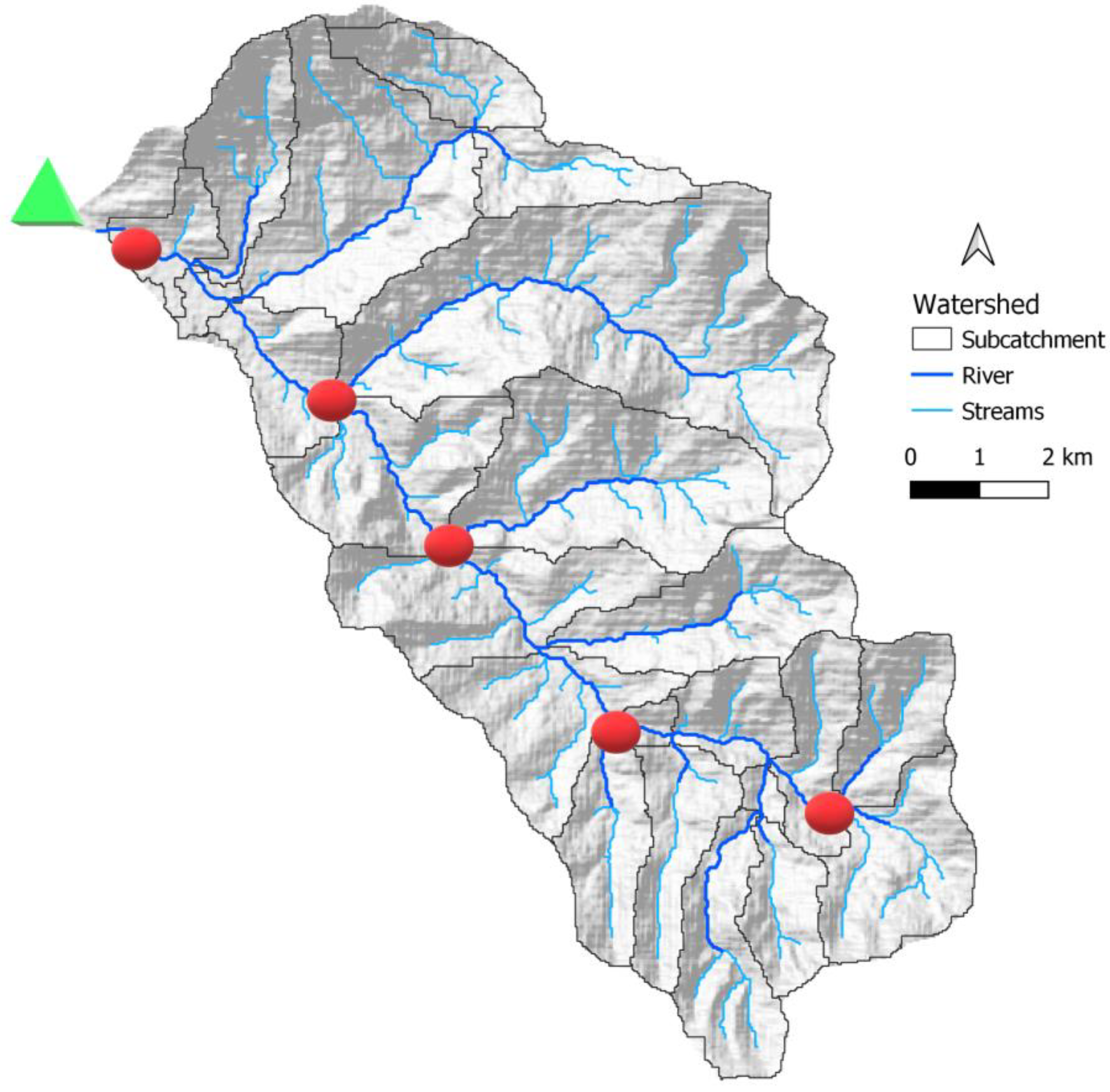
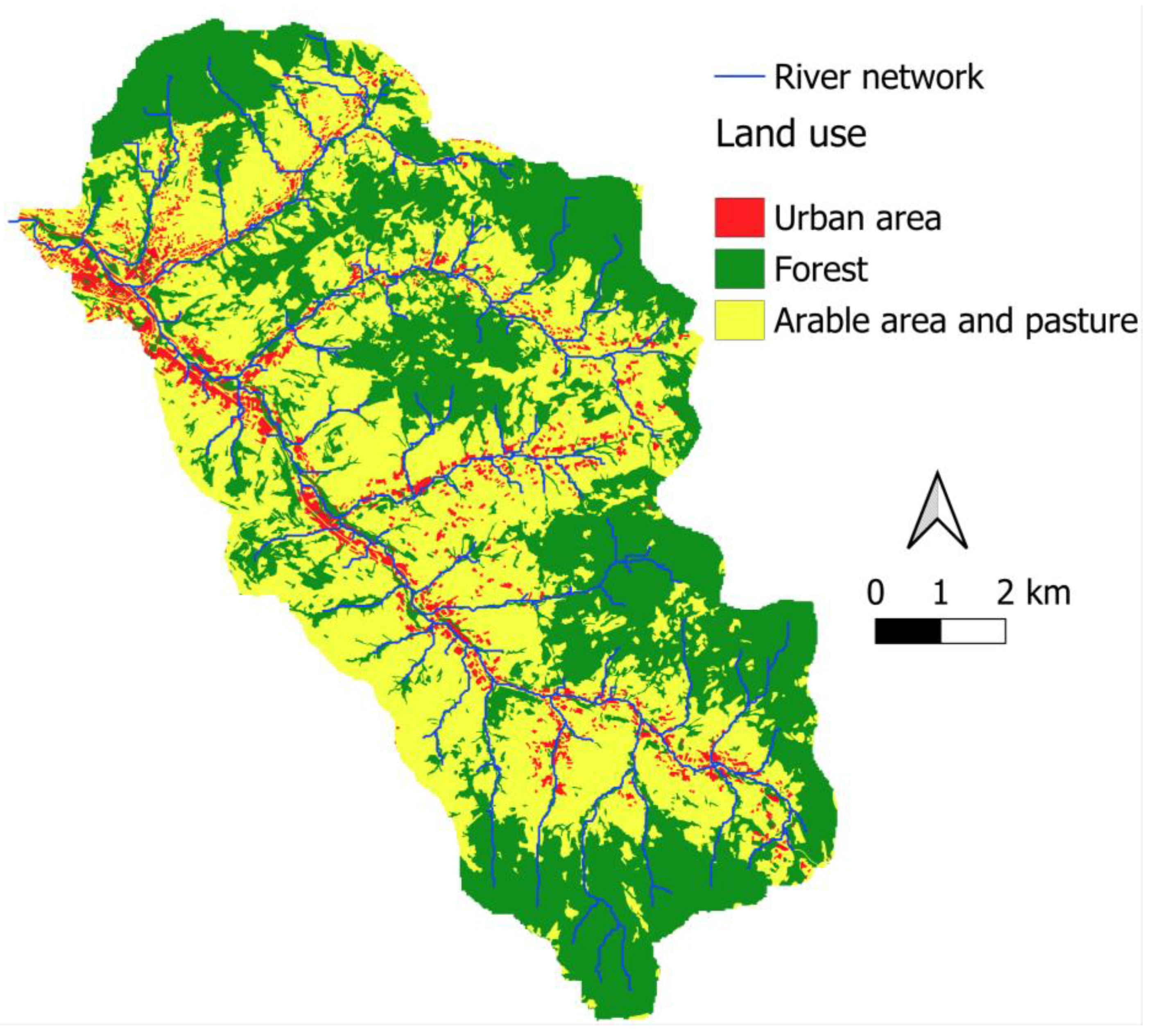





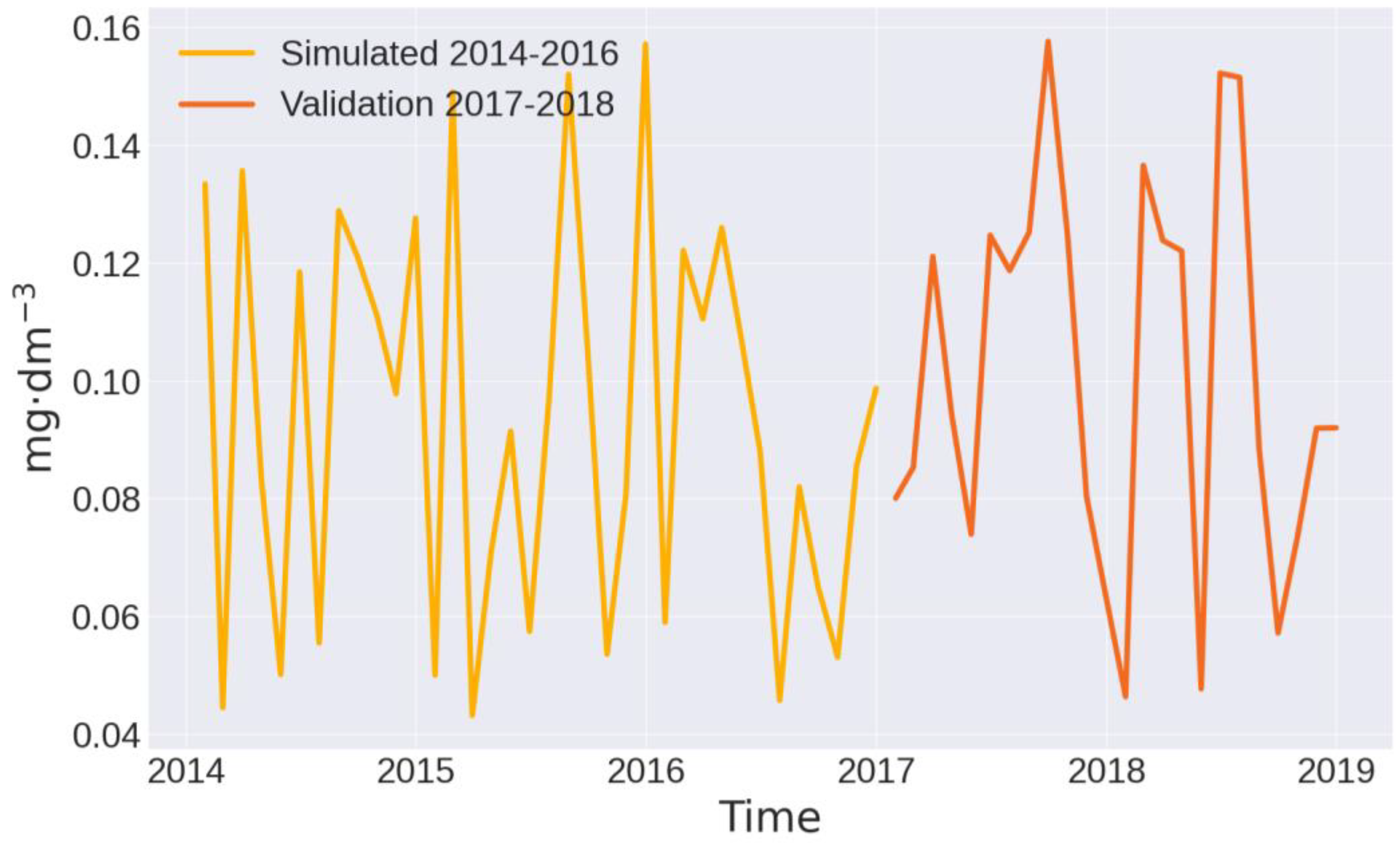

References
- Centanni, M.; Ricci, G.F.; De Girolamo, A.M.; Gentile, F. Modeling pesticides and ecotoxicological risk assessment in an intermittent river using SWAT. Sci. Rep. 2024, 14, 6389. [Google Scholar] [CrossRef]
- Bärlund, I.; Kirkkala, T.; Malve, O.; Kämäri, J. Assessing SWAT model performance in the evaluation of management actions for the implementation of the Water Framework Directive in a Finnish catchment. Environ. Model. Softw. 2007, 22, 719–724. [Google Scholar] [CrossRef]
- Malagó, A.; Bouraoui, F.; Vigiak, O.; Grizzetti, B.; Pastori, M. Modelling water and nutrient fluxes in the Danube River Basin with SWAT. Sci. Total Environ. 2017, 603, 196–218. [Google Scholar] [CrossRef]
- Németová, Z.; Kohnová, S. Mathematical modeling of soil erosion processes using physically-based and empirical models: Case study of Slovakia and central Poland. Acta Hydrol. Slovaca 2021, 22, 147–155. [Google Scholar] [CrossRef]
- Akan, C.J.; Abbagambo, M.T.; Chellube, Z.M.; Abdulrahman, F.I. Assessment of Pollutants in Water and Sediment Samples in Lake Chad. Baga, North Eastern Nigeria. J. Environ. Prot. 2012, 3, 1428–1441. [Google Scholar] [CrossRef]
- Purandara, B.K.; Varadarajan, N.; Venkatesh, B.; Choubey, V.K. Surface Water Quality Evaluation and Modeling of Ghataprabha River, Karnataka, India. Environ. Monit. Assess. 2012, 184, 1371–1378. [Google Scholar] [CrossRef]
- Bedla, D.; Misztal, A. Changeability of Chemistry of Small Water Reservoirs with Diversified Use Structure of the Adjoining Areas. Rocz. Ochr. Srodowiska 2014, 16, 421–439. [Google Scholar]
- Halecki, W.; Kowalik, T.; Bogdał, A. Multiannual Assessment of the Risk of Surface Water Erosion and Metal Accumulation Indices in the Flysch Stream Using the MARS Model in the Polish Outer Western Carpathians. Sustainability 2019, 11, 7189. [Google Scholar] [CrossRef]
- da Silva, A.M. Rainfall erosivity map of Brazil. Catena 2004, 57, 251–259. [Google Scholar] [CrossRef]
- Robson, B. State of the Art in Modelling of Phosphorus in Aquatic Systems: Review, Criticisms and Commentary. Environ. Model Softw. 2014, 61, 339–359. [Google Scholar] [CrossRef]
- Brocca, L.; Moramarco, T.; Melone, F.; Wagner, W.; Hasenauer, S.; Hahn, S. Assimilation of surface and root-zone ASCAT soil moisture products into rainfall-runoff modelling. IEEE Trans. Geosci. Remote Sens. 2012, 50, 2542–2555. [Google Scholar] [CrossRef]
- Seneviratne, S.I.; Corti, T.; Davin, E.L.; Hirschi, M.; Jaeger, E.B.; Lehner, I.; Orlowsky, B. Investigating Soil Moisture-Climate Interactions in a Changing Climate: A Review. Earth-Sci. Rev. 2010, 99, 125–161. [Google Scholar] [CrossRef]
- Kowalczyk, A.; Twardy, S. Wielkość erozji wodnej obliczona metodą USLE. Woda-Sr.-Obsz. Wiej. 2012, 12, 83–92. [Google Scholar]
- Vermeulen, H.R.; Nieuwenhuis, J.D. Kinetic Energy Rainfall Relationship for Central Cebu, Philippines for Soil Erosion. J. Hydrol. 2005, 300, 20–32. [Google Scholar]
- Mostowik, K.; Krzyczman, D.; Płaczkowska, E.; Rzonca, B.; Siwek, J.; Wacławczyk, P. Spring recharge and groundwater flow patterns in flysch aquifer in the Połonina Wetlińska Massif in the Carpathian Mountains. J. Mt. Sci. 2021, 18, 819–833. [Google Scholar] [CrossRef]
- Obi, M.E.; Salako, F.K. Rainfall Parameters Influencing Erosivity in Southeastern Nigeria. Catena 1995, 24, 275–287. [Google Scholar] [CrossRef]
- Gil, E.; Kijowska-Strugała, M.; Demczuk, P. Soil erosion dynamics on a cultivated slope in the Western Polish Carpathians based on over 30 years of plot studies. Catena 2021, 207, 105682. [Google Scholar] [CrossRef]
- Zhao, Z.; Zhou, Y.; Wang, X.; Wang, Z.; Bai, Y. Water Quality Evolution Mechanism Modeling and Health Risk Assessment Based on Stochastic Hybrid Dynamic Systems. Expert Syst. Appl. 2022, 191, 116404. [Google Scholar] [CrossRef]
- Moreno, J.; Campagnolo, L.; Boitier, B.; Nikas, A.; Koasidis, K.; Gambhir, A.; Vielle, M. The Impacts of Decarbonization Pathways on Sustainable Development Goals in the European Union. Commun. Earth Environ. 2024, 5, 136. [Google Scholar] [CrossRef]
- Kondracki, J. Geografia Regionalna Polski; Wydawnictwo Naukowe PWN: Wydawnictwo Naukowe PWN, 2011. [Google Scholar]
- Loga, M. Wody Pod Presją—Praktyczny Kurs Oceny Presji Obiektów Gospodarki Komunalnej na Wody Powierzchniowe; Praca Zbiorowa: Warszawa, Poland, 2016; ISBN 978-83-937934-4-0. [Google Scholar]
- Gordon, N.D.; McMahon, T.A.; Finlayson, B.L.; Gippel, C.J.; Nathan, R.J. Stream Hydrology: An Introduction for Ecologists; John Wiley and Sons: Hoboken, NJ, USA, 2004. [Google Scholar]
- Weslati, O.; Serbaji, M.M. Spatial Assessment of Soil Erosion by Water Using RUSLE Model, Remote Sensing and GIS: A Case Study of Mellegue Watershed, Algeria–Tunisia. Environ. Monit. Assess. 2024, 196, 14. [Google Scholar] [CrossRef] [PubMed]
- Rangel, T.F.L.V.B.; Diniz-Filho, J.A.F.; Bini, L.M. SAM: A Comprehensive Application for Spatial Analysis in Macroecology. Ecography 2010, 33, 46–50. [Google Scholar] [CrossRef]
- Nasirzadehdizaji, R.; Akyüz, D.E. Application of SWAT Hydrological Model to Assess the Impacts of Land Use Change on Sediment Loads. Int. J. Agric. Environ. Food Sci. 2022, 6, 108–120. [Google Scholar] [CrossRef]
- Senent-Aparicio, J.; George, C.; Srinivasan, R. Introducing a New Post-Processing Tool for the SWAT+ Model to Evaluate Environmental Flows. Environ. Model Softw. 2021, 136, 104944. [Google Scholar] [CrossRef]
- Basha, G.; Ouarda, T.B.M.J.; Marpu, P.R. Long-term projections of temperature, precipitation and soil moisture using non-stationary oscillation processes over the UAE region. Int. J. Climatol. 2015, 35, 4606–4618. [Google Scholar] [CrossRef]
- Smoroń, S.; Kowalczyk, A.; Kostuch, M. Użytkowanie Gruntów Zlewni Szreniawy w Kontekście Ochrony Gleby i Wody w Latach 1995–2005. Woda-Sr.-Obsz. Wiej. 2009, 9, 167–179. [Google Scholar]
- Abeysingha, N.S.; Singh, M.; Sehgal, V.K.; Khanna, M.; Pathak, H.; Jayakody, P.; Srinivasan, R. Assessment of water yield and evapotranspiration over 1985 to 2010 in the Gomti River basin in India using the SWAT model. Curr. Sci. 2015, 108, 2202–2212. [Google Scholar]
- Bedla, D.; Król, K. The impact of land use on water quality in rural pond on the example of the pond Zelków. Acta Sci. Polonorum. Form. Circumiectus 2014, 13, 25. [Google Scholar] [CrossRef]
- Luis, A.T.; Teixeira, P.; Almeida, S.F.; Matos, J.X.; da Silva, E.F. Environmental impact of mining activities in the Lousal area (Portugal): Chemical and diatom characterization of metal contaminated stream sediments and surface water of Corona stream. Sci. Total Environ. 2011, 409, 4312–4325. [Google Scholar] [CrossRef]
- Woo, S.Y.; Kim, S.J.; Lee, J.W.; Kim, S.H.; Kim, Y.W. Evaluating the Impact of Interbasin Water Transfer on Water Quality in the Recipient River Basin with SWAT. Sci. Total Environ. 2021, 776, 145984. [Google Scholar] [CrossRef]
- Halecki, W.; Kruk, E.; Ryczek, M. Evaluation of water erosion at a mountain catchment in Poland using the G2 model. Catena 2018, 164, 116–124. [Google Scholar] [CrossRef]
- Stępniewski, K.; Demczuk, P.; Rodzik, J.; Siwek, K. Związki Między Opadem Deszczu a Spływem Powierzchniowym i Spłukiwaniem Gleby na Poletkach Doświadczalnych o Różnym Użytkowaniu (Guciów—Roztocze Środkowe). Pract. Stud. Geogr. 2010, 45, 229–241. [Google Scholar]
- Halecki, W.; Kruk, E.; Ryczek, M. Estimations of nitrate nitrogen, total phosphorus flux and suspended sediment concentration (SSC) as indicators of surface-erosion processes using an ANN (Artificial Neural Network) based on geomorphological parameters in mountainous catchments. Ecol. Indic. 2018, 91C, 461–469. [Google Scholar] [CrossRef]
- Łach, J. Rola Gwałtownych Ulew i Powodzi w Modelowaniu Rzeźby Kotliny Kłodzkiej oraz Zachodnich Pasm Górskich Sudetów Wschodnich; Instytut Geografii i Rozwoju Regionalnego UW: Wrocław, Poland, 2012. [Google Scholar]
- Baryła, A. 2004. Erozyjność deszczy w rejonie Puczniewa. Przeg. Nauk. Inżynierii Kształtowania Sr. 2004, 13, 48–54. [Google Scholar]
- Wu, S.; Tetzlaff, D.; Goldhammer, T.; Soulsby, C. Hydroclimatic Variability and Riparian Wetland Restoration Control the Hydrology and Nutrient Fluxes in a Lowland Agricultural Catchment. J. Hydrol. 2021, 603, 126904. [Google Scholar] [CrossRef]
- Richards, G.; Gilmore, T.E.; Mittelstet, A.R.; Messer, T.L.; Snow, D.D. Baseflow Nitrate Dynamics within Nested Watersheds of an Agricultural Stream in Nebraska, USA. Agric. Ecosyst. Environ. 2021, 308, 107223. [Google Scholar] [CrossRef]
- Wu, S.; Tetzlaff, D.; Yang, X.; Soulsby, C. Disentangling the Influence of Landscape Characteristics, Hydroclimatic Variability and Land Management on Surface Water NO3-N Dynamics: Spatially Distributed Modeling Over 30 yr in a Lowland Mixed Land Use Catchment. Water Resour. Res. 2022, 58, e2021WR030566. [Google Scholar] [CrossRef]
- Haritash, A.K.; Gaur, S.; Garg, S. Assessment of water quality and suitability analysis of River Ganga in Rishikesh, India. Appl. Water Sci. 2016, 6, 383–392. [Google Scholar] [CrossRef]
- Barbayiannis, N.; Panayotopoulos, K.; Psaltopoulos, D.; Skuras, D. The influence of policy on soil conservation: A case study from Greece. Land Degrad. Dev. 2011, 22, 47–57. [Google Scholar] [CrossRef]
- Starkel, L. Geomorphic Hazards in the Polish Flysch Carpathians. Stud. Geomorphol. Carpatho-Balc. 2006, 40, 7–19. [Google Scholar]
- Meusburger, K.; Steel, A.; Panagos, P.; Montanarella, L.; Alewell, C. Spatial and temporal variability of rainfall erosivity factor for Switzerland. Hydrol. Earth Syst. Sci. 2012, 16, 167–177. [Google Scholar] [CrossRef]
- Kruk, E. Influence of daily precipitation on yield of eroded soil in mountain basin using the MUSLE model. Acta Sci. Pol. Form. Circumiectus 2017, 16, 147–158. [Google Scholar] [CrossRef]
- Lin, B.; Chen, X.; Yao, H.; Chen, Y.; Liu, M.; Gao, L.; James, A. Analyses of landuse change impacts on catchment runoff using different time indicators based on SWAT model. Ecol. Indic. 2015, 58, 55–63. [Google Scholar] [CrossRef]
- Wang, R.; Liu, Z.; Yao, Z.; Lei, Y. Modeling the Risk of Nitrate Leaching and Nitrate Runoff Loss from Intensive Farmland in the Baiyangdian Basin of the North China Plain. Environ. Earth Sci. 2014, 10, 3143–3157. [Google Scholar] [CrossRef]
- Zheng, Z.; He, S. Change of Soil Surface Roughness of Splash Erosion Process. In Research on Soil Erosion; Godone, D., Stanchi, S., Eds.; IntechOpen: London, UK, 2012. [Google Scholar]
- Hao, H.X.; Wang, J.G.; Guo, Z.L.; Hua, L. Water erosion processes and dynamic changes of sediment size distribution under the combined effects of rainfall and overland flow. Catena 2019, 173, 494–504. [Google Scholar] [CrossRef]
- Liao, Y.; Yuan, Z.; Zhuo, M.; Huang, B.; Nie, X.; Xie, Z.; Tang, C.; Li, D. Coupling effects of erosion and surface roughness on colluvial deposits under continuous rainfall. Soil Tillage Res. 2019, 191, 98–107. [Google Scholar] [CrossRef]
- Dabral, P.P.; Baithuri, A.; Pandey, A. Soil erosion assessment in a hilly catchment of North Eastern India using USLE, GIS and remote sensing. Water Resour. Manag. 2008, 22, 1783–1798. [Google Scholar] [CrossRef]
- Kowalczyk, A.W.; Grabowska-Polanowska, B.; Garbowski, T.; Kopacz, M.; Lach, S.; Mazur, R. A Multicriteria Approach to Different Land Use Scenarios in the Western Carpathians with the SWAT Model. J. Water Land Dev. 2023, 57, 130–139. [Google Scholar] [CrossRef]
- Martínez-Mena, M.; Carrillo-López, E.; Boix-Fayos, C.; Almagro, M.; Franco, N.G.; Díaz-Pereira, E.; De Vente, J. Long-term effectiveness of sustainable land management practices to control runoff, soil erosion, and nutrient loss and the role of rainfall intensity in Mediterranean rainfed agroecosystems. Catena 2020, 187, 104352. [Google Scholar] [CrossRef]
- Starkel, L. Złożoność Czasowa i Przestrzenna Opadów Ekstremalnych—Ich Efekty Geomorfologiczne i Drogi Przeciwdziałania Im. Landf. Anal. 2011, 15, 65–80. [Google Scholar]
- Kanownik, W. Impact of mountainous areas management system upon biogenes content in surface waters. Electron. J. Pol. Agric. Univ. 2005, 8, 11. [Google Scholar]
- Frąk, M.; Baryła, A. Assessment of the state of water quality of the Dzierzgoń Lake using chemical and biological indicators. Ann. Wars. Univ.—SGGW. Land Reclam. 2012, 44, 111–119. [Google Scholar]
- Gao, X.; Wu, P.; Zhao, X.; Wang, J.; Shi, Y. Effects of land use on soil moisture. Variations in a semi-arid catchment: Implications for land and agricultural water management. Land Degrad. Dev. 2014, 25, 163–172. [Google Scholar] [CrossRef]
- Chiwa, M. Long-term changes in atmospheric nitrogen deposition and stream water nitrate leaching from forested watersheds in western Japan. Environ. Pollut. 2021, 287, 117634. [Google Scholar] [CrossRef] [PubMed]
- Janicka, E.; Kanclerz, J.; Agaj, T.; Policht-Latawiec, A. Variability of concentrations of phosphorus forms under the conditions of weir renovation–The Głuszynka river-lake system case study. J. Water Land Dev. 2024, 6, 183–189. [Google Scholar] [CrossRef]


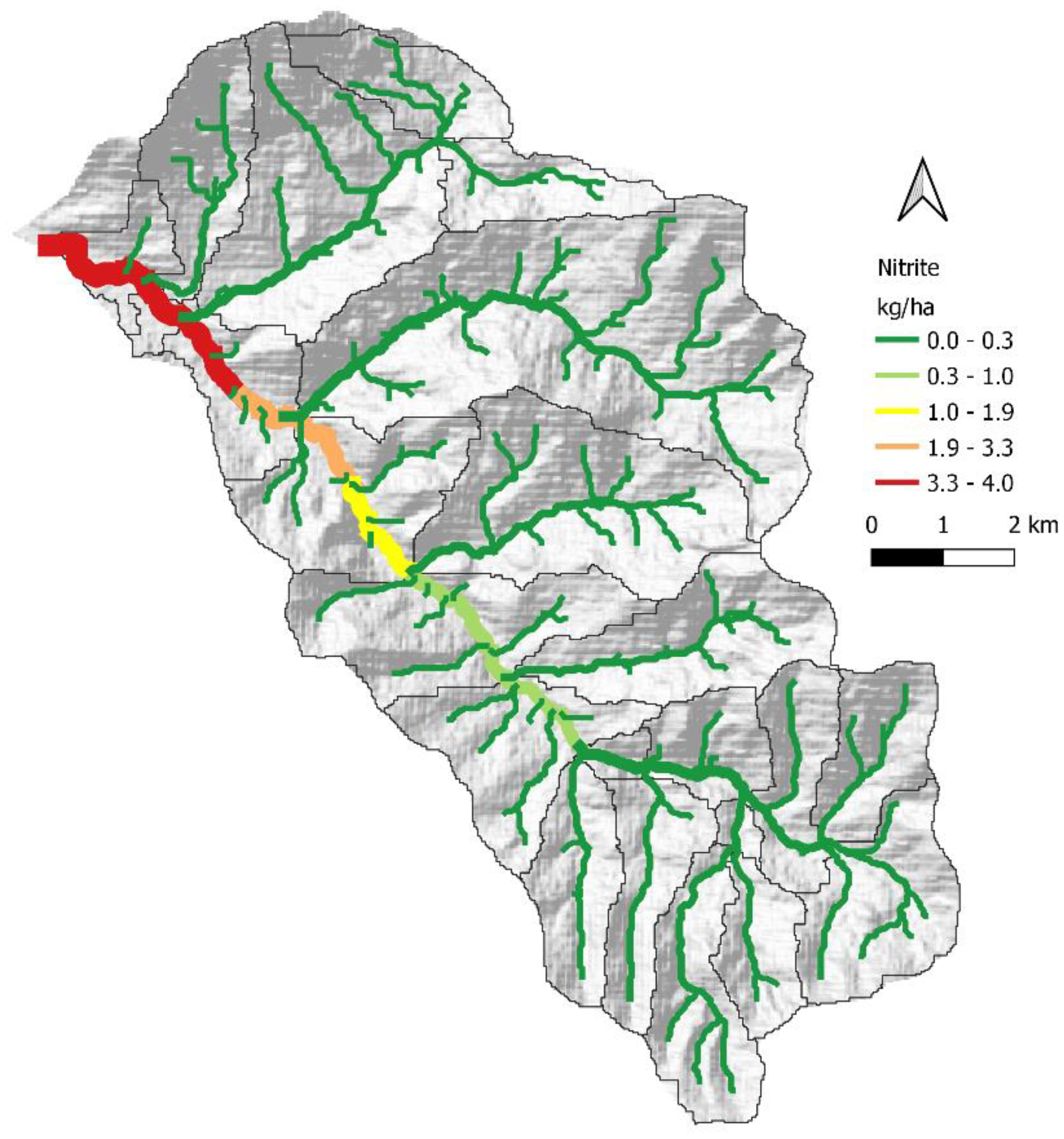
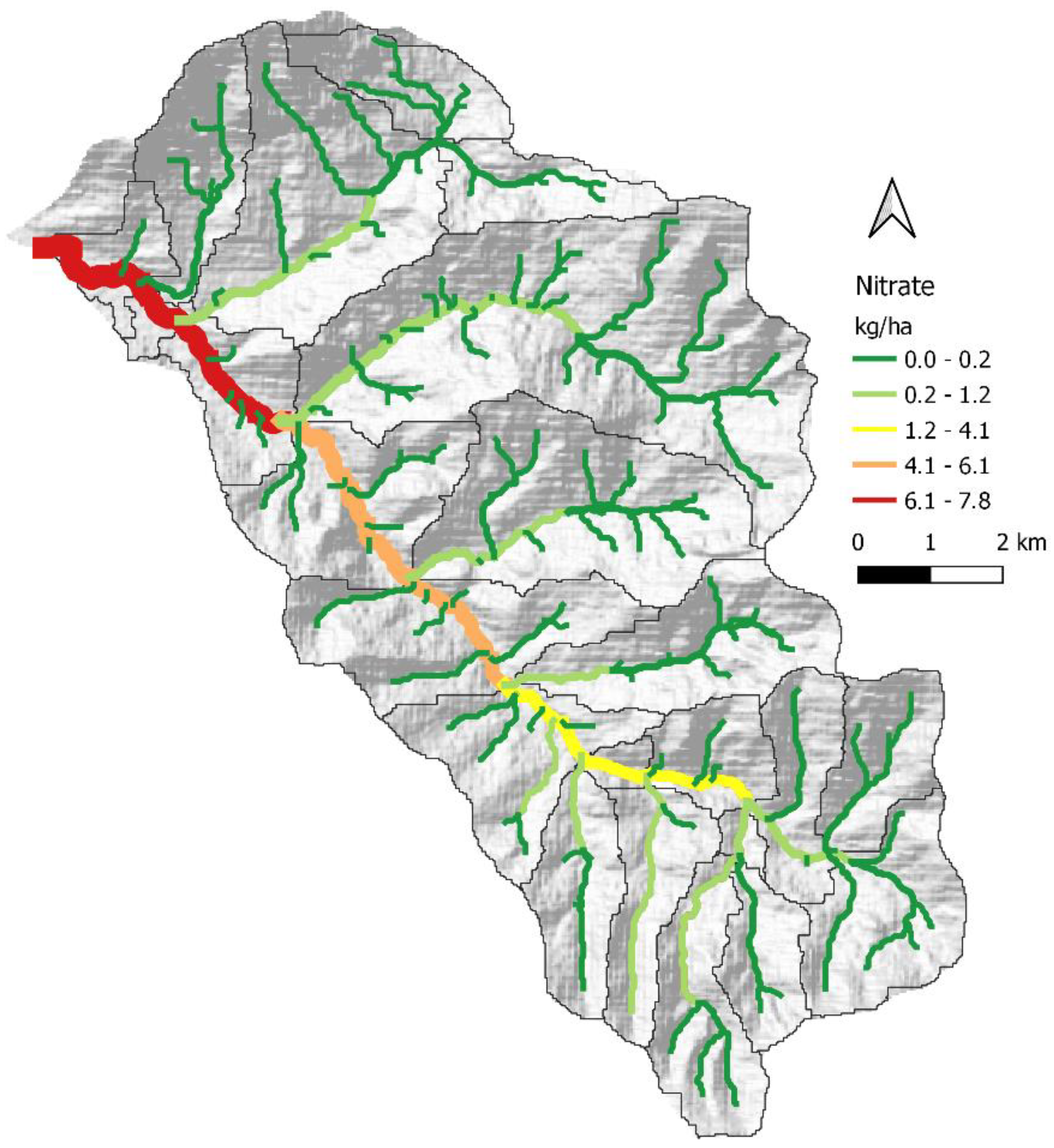
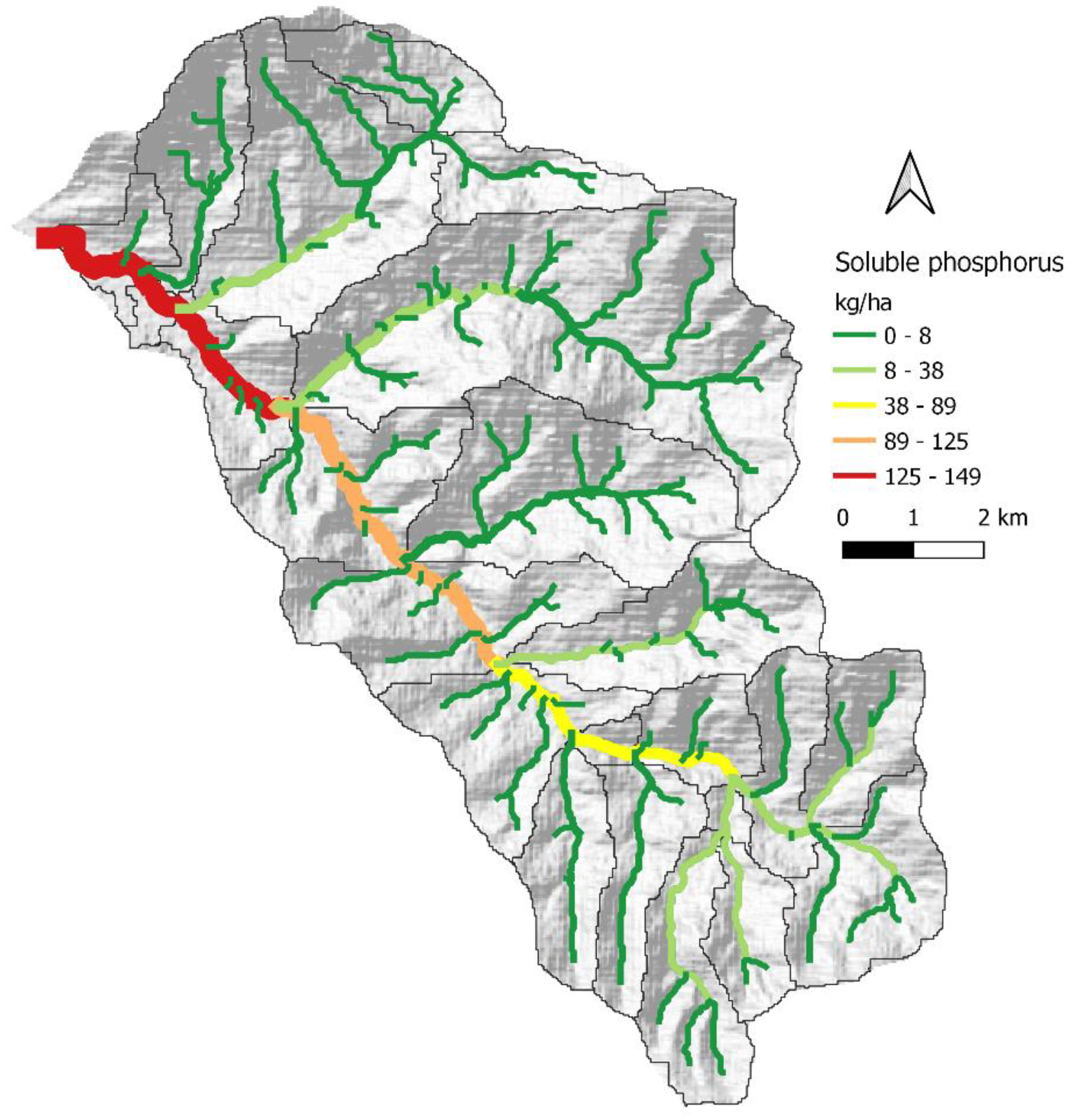

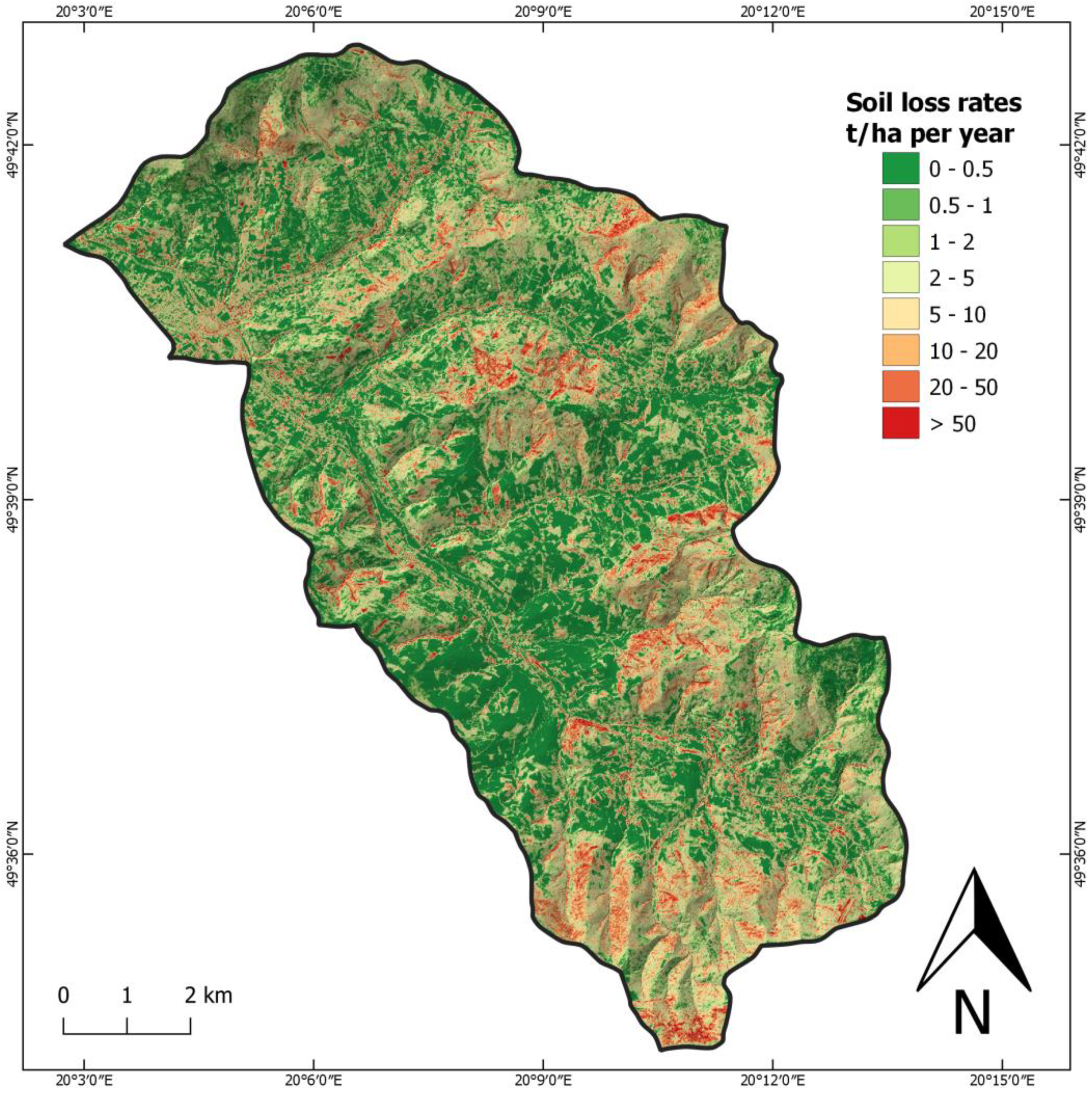
| Cross-Section | N-NH4+ | N-NO2− | N-NO3− | P-PO43− | TSS | Discharge |
|---|---|---|---|---|---|---|
| mg/dm3 | m3/s | |||||
| 1 | 0.88 | 0.09 | 0.72 | 0.11 | 12.54 | 0.68–0.91 |
| 2 | 0.97 | 0.10 | 0.81 | 0.15 | 5.75 | 0.75–1.01 |
| 3 | 0.81 | 0.39 | 1.29 | 0.19 | 2.71 | 1.22–1.44 |
| 4 | 0.92 | 0.48 | 1.58 | 0.24 | 4.56 | 1.42–1.98 |
| 5 | 0.95 | 0.61 | 1.89 | 0.32 | 2.24 | 1.96–2.34 |
| Hydrodynamic Gauges | Arable Lands | Pasture | Forests | |
|---|---|---|---|---|
| Transport intensity | m3·s−1 | 2.93 | 0.77 | 0.47 |
| Transverse turbulence diffusion coefficient | m2·s−1 | 0.094 | 0.057 | 0.065 |
| Complete vertical or transverse mixing | m | 62.29 | 51.19 | 45.13 |
| Variables | SAR Coefficient | Standard Coefficient | Standard Error | t | p |
|---|---|---|---|---|---|
| Intercept | 3.462 | - | 3.345 | 2.23 | 2.50 |
| N-NO3− | −0.853 | 0.823 | 0.83 | −4.06 | 0.030 * |
| N-NO2− | −2.503 | −0.367 | 1.34 | −8.25 | 0.932 |
| N-NH4+ | 0.09 | 0.077 | 0.02 | 0.36 | 0.582 |
| P-PO43− | −0.43 | 1.14 | 1.67 | 3.97 | 0.342 |
| TSS | −0.324 | 0.034 | 0.01 | 0.03 | 0.024 * |
| Variables | SAR Coefficient | Standard Coefficient | Standard Error | t | p |
|---|---|---|---|---|---|
| Intercept | 1.039 | - | 2.402 | 1.432 | 5.450 |
| N-NO3− | −0.323 | 0.823 | 0.831 | −4.010 | 0.332 |
| N-NO2− | 2.422 | −0.632 | 1.314 | −8.304 | 0.635 |
| N-NH4+ | 0.294 | 0.027 | 0.534 | 0.670 | 0.672 |
| P-PO43− | −0.432 | 1.203 | 1.367 | 3.971 | 0.023 * |
| TSS | −0.324 | 0.034 | 0.013 | 0.933 | 0.023 * |
| Variables | SAR Coefficient | Standard Coefficient | Standard Error | t | p |
|---|---|---|---|---|---|
| Intercept | 1.034 | - | 3.345 | 2.31 | 1.023 |
| N-NO3− | −0.034 | 0.902 | 0.843 | 4.036 | 0.023 * |
| N-NO2− | −2.503 | −0.224 | 0.344 | −3.25 | 0.292 |
| N-NH4+ | 0.09 | 0.932 | 0.564 | 2.36 | 0.476 |
| P-PO43− | −0.43 | 1.14 | 0.643 | 1.947 | 0.368 |
| TSS | −0.324 | 0.034 | 0.487 | 0.432 | 0.766 |
| KGE | R2 | PBIAS (%) | ||||
|---|---|---|---|---|---|---|
| Associated Variable | Calibration | Validation | Calibration | Validation | Calibration | Validation |
| N-NO3− | 0.45 | 0.35 | 0.35 | 0.36 | 4.24 | −1.36 |
| N-NO2− | 0.76 | 0.52 | 0.26 | 0.27 | 1.35 | 1.46 |
| N-NH4+ | 0.57 | 0.66 | 0.27 | 0.36 | 1.36 | 3.74 |
| P-PO43− | 0.54 | 0.32 | 0.36 | 0.37 | −1.35 | −1.40 |
| Flow | 0.76 | 0.61 | 0.56 | 0.56 | −4.43 | −2.24 |
| TSS | 0.73 | 0.65 | 0.67 | 0.71 | 2.42 | 2.25 |
| Parameter | Description | Unit | Source |
|---|---|---|---|
| Weather data | |||
| Precipitation | Monthly rainfall data | mm/day | Local weather station |
| Temperature | Monthly maximum and minimum temperatures | °C | Local weather station |
| Solar radiation | Monthly solar radiation | MJ/m/day | Local weather station |
| Relative humidity | Monthly relative humidity | % | Local weather station |
| Wind speed | Monthly wind speed | m/s | Local weather station |
| Land use and management | |||
| Land use | Land use classification | - | Satellite imagery |
| Crop management | Crop types and planting and harvesting dates | - | Agricultural records |
| Tillage practices | Tillage types and schedules | - | Agricultural records |
| Fertilizer application | Fertilizer types, application rates, and schedules | kg/ha | Agricultural records |
| Soil data | |||
| Soil texture | Soil texture classification | - | Head Office of Geodesy and Cartography in Poland |
| Hydrological data | |||
| Streamflow | Monthly streamflow | m/s | River gauging stations |
Disclaimer/Publisher’s Note: The statements, opinions and data contained in all publications are solely those of the individual author(s) and contributor(s) and not of MDPI and/or the editor(s). MDPI and/or the editor(s) disclaim responsibility for any injury to people or property resulting from any ideas, methods, instructions or products referred to in the content. |
© 2024 by the authors. Licensee MDPI, Basel, Switzerland. This article is an open access article distributed under the terms and conditions of the Creative Commons Attribution (CC BY) license (https://creativecommons.org/licenses/by/4.0/).
Share and Cite
Halecki, W.; Bedla, D. Surface Flux Patterns of Nutrient Concentrations and Total Suspended Solids in Western Carpathian Stream within Agricultural, Forest, and Grassland Landscapes. Water 2024, 16, 2052. https://doi.org/10.3390/w16142052
Halecki W, Bedla D. Surface Flux Patterns of Nutrient Concentrations and Total Suspended Solids in Western Carpathian Stream within Agricultural, Forest, and Grassland Landscapes. Water. 2024; 16(14):2052. https://doi.org/10.3390/w16142052
Chicago/Turabian StyleHalecki, Wiktor, and Dawid Bedla. 2024. "Surface Flux Patterns of Nutrient Concentrations and Total Suspended Solids in Western Carpathian Stream within Agricultural, Forest, and Grassland Landscapes" Water 16, no. 14: 2052. https://doi.org/10.3390/w16142052
APA StyleHalecki, W., & Bedla, D. (2024). Surface Flux Patterns of Nutrient Concentrations and Total Suspended Solids in Western Carpathian Stream within Agricultural, Forest, and Grassland Landscapes. Water, 16(14), 2052. https://doi.org/10.3390/w16142052







